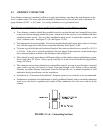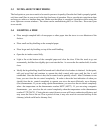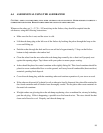33
• Never operate the stove with the door open, or cracked slightly open, except briefly during the
lighting operation, and during refuelling. Leaving the door open continuously could seriously
overheat the chimney and adjacent combustibles. Do not operate the stove if there is an abnormal air
leakage into the stove, such as through deteriorated gaskets or cracked or broken glass. Do not
operate the stove without a door gasket. Leakage can result in overheating, or in very airtight homes,
could possibly cause smoking into the room. Smoke may contain carbon monoxide, which is
poisonous, and in sufficient quantities, is a health hazard.
3.2 FUEL
Fuel for the stove must not be stored closer than the required clearances to combustibles (heat sensitive
materials). NEVER STORE WOOD IN THE ASH PAN COMPARTMENT.
Your Drolet stove is designed to burn
WOOD ONLY. Do not burn coal, charcoal, or trash in the unit.
Highly flammable items such as trash may ignite creosote in the chimney (flue), resulting in a chimney
fire. Never burn salt wood, beach wood, chemically treated wood, or wood removed from salt water,
since the deposits left will deteriorate the firebox. Damage caused by chemicals or salt is not covered
under warranty.
Seasoned cord wood is recommended. Wood should be air dried in a covered and ventilated area for a
minimum of six months (one year or more is recommended). This reduces the moisture content of the
wood, resulting in a better stove performance. Wood species with moisture content of 20% or less are
ideal. Dry, seasoned cord wood, can be distinguished from green wood by the cracks at each end of the
logs. Wet or green wood will tend to cause the fire to smoulder, producing large amounts of creosote.
Creosote buildup could result in a chimney fire. This wood will also prove difficult to keep burning
properly, and fires will tend to go out. Green wood produces very little heat, and sometimes causes
customers to think that the stove does not work.
Decayed wood or low-density wood has very little energy content or heating value, and will not burn
satisfactorily for long periods of time. An example of the energy values of some common wood fuels
found un North America is given in Table 3.2 below.


















